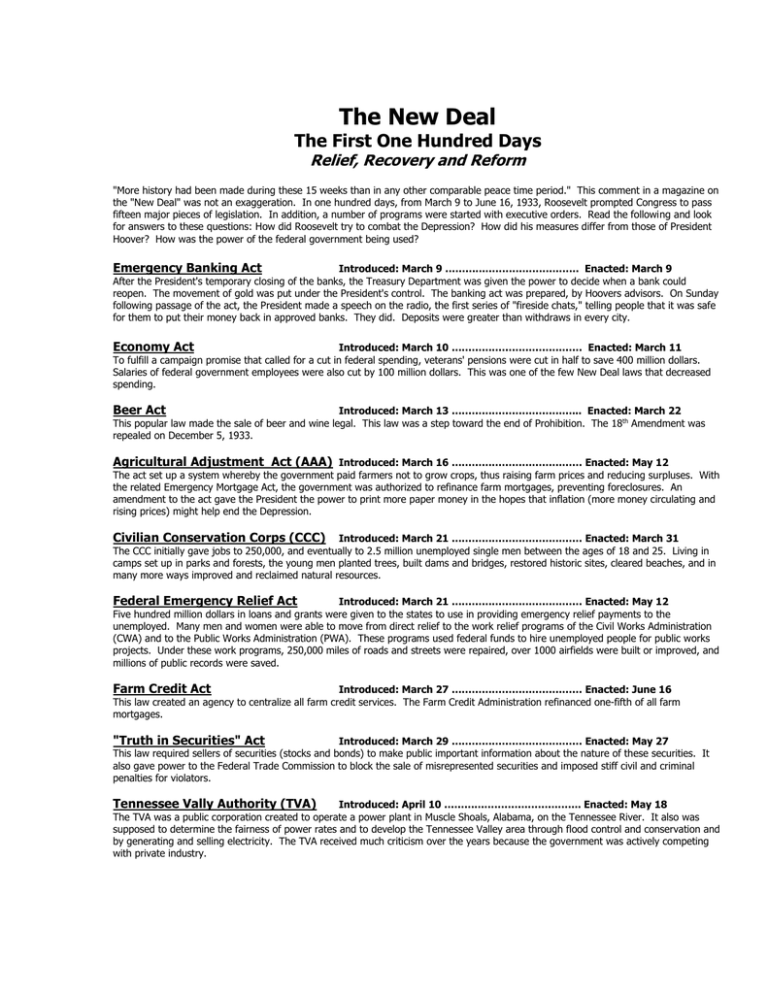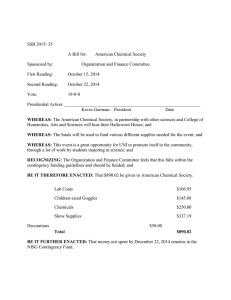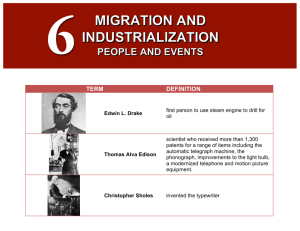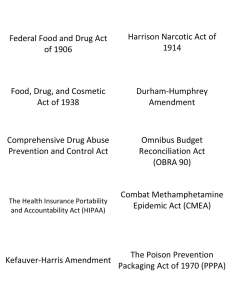The New Deal The First One Hundred Days Relief, Recovery and Reform
advertisement

The New Deal The First One Hundred Days Relief, Recovery and Reform "More history had been made during these 15 weeks than in any other comparable peace time period." This comment in a magazine on the "New Deal" was not an exaggeration. In one hundred days, from March 9 to June 16, 1933, Roosevelt prompted Congress to pass fifteen major pieces of legislation. In addition, a number of programs were started with executive orders. Read the following and look for answers to these questions: How did Roosevelt try to combat the Depression? How did his measures differ from those of President Hoover? How was the power of the federal government being used? Emergency Banking Act Introduced: March 9 …………………………………. Enacted: March 9 After the President's temporary closing of the banks, the Treasury Department was given the power to decide when a bank could reopen. The movement of gold was put under the President's control. The banking act was prepared, by Hoovers advisors. On Sunday following passage of the act, the President made a speech on the radio, the first series of "fireside chats," telling people that it was safe for them to put their money back in approved banks. They did. Deposits were greater than withdraws in every city. Economy Act Introduced: March 10 ………………………………… Enacted: March 11 To fulfill a campaign promise that called for a cut in federal spending, veterans' pensions were cut in half to save 400 million dollars. Salaries of federal government employees were also cut by 100 million dollars. This was one of the few New Deal laws that decreased spending. Beer Act Introduced: March 13 ………………………………... Enacted: March 22 This popular law made the sale of beer and wine legal. This law was a step toward the end of Prohibition. The 18th Amendment was repealed on December 5, 1933. Agricultural Adjustment Act (AAA) Introduced: March 16 ………………………………… Enacted: May 12 The act set up a system whereby the government paid farmers not to grow crops, thus raising farm prices and reducing surpluses. With the related Emergency Mortgage Act, the government was authorized to refinance farm mortgages, preventing foreclosures. An amendment to the act gave the President the power to print more paper money in the hopes that inflation (more money circulating and rising prices) might help end the Depression. Civilian Conservation Corps (CCC) Introduced: March 21 ………………………………… Enacted: March 31 The CCC initially gave jobs to 250,000, and eventually to 2.5 million unemployed single men between the ages of 18 and 25. Living in camps set up in parks and forests, the young men planted trees, built dams and bridges, restored historic sites, cleared beaches, and in many more ways improved and reclaimed natural resources. Federal Emergency Relief Act Introduced: March 21 ………………………………… Enacted: May 12 Five hundred million dollars in loans and grants were given to the states to use in providing emergency relief payments to the unemployed. Many men and women were able to move from direct relief to the work relief programs of the Civil Works Administration (CWA) and to the Public Works Administration (PWA). These programs used federal funds to hire unemployed people for public works projects. Under these work programs, 250,000 miles of roads and streets were repaired, over 1000 airfields were built or improved, and millions of public records were saved. Farm Credit Act Introduced: March 27 ………………………………… Enacted: June 16 This law created an agency to centralize all farm credit services. The Farm Credit Administration refinanced one-fifth of all farm mortgages. "Truth in Securities" Act Introduced: March 29 ………………………………… Enacted: May 27 This law required sellers of securities (stocks and bonds) to make public important information about the nature of these securities. It also gave power to the Federal Trade Commission to block the sale of misrepresented securities and imposed stiff civil and criminal penalties for violators. Tennessee Vally Authority (TVA) Introduced: April 10 ………………………………….. Enacted: May 18 The TVA was a public corporation created to operate a power plant in Muscle Shoals, Alabama, on the Tennessee River. It also was supposed to determine the fairness of power rates and to develop the Tennessee Valley area through flood control and conservation and by generating and selling electricity. The TVA received much criticism over the years because the government was actively competing with private industry. Home Owners' Loan Act Introduced: April 13 …………………………………. Enacted: June 13 Modeled on the Farm Credit Act, this law formed the Home Owners' Loan Corporation (HOLC) to refinance individual home mortgages at low interest for up to fifteen years. Thousands of home owners threatened with foreclosure or eviction were saved by HOLC loans. The HOLC eventually helped refinance one-fifth of all mortgaged urban homes. Railroad Coordination Act Introduced: May 4 ……………………………………. Enacted: June 16 This act attempted to rescue the depressed railroad industry by enforcing consolidation, rate-making reforms, and other economy measures. The goal, never realized, was a coordinated transportation system. National Industrial Recovery Act (NIRA) Introduced: May 17………….. Enacted: June 16 In perhaps the most far reaching of all the laws, Congress gave the President power to manage the nation's business life. To stimulate the recovery of private business and to spread work among as many men and women as possible, Roosevelt established the National Recovery Administration (NRA). Businesses were to plan together, without fear of anti-trust suits, to set up codes for making, marketing and pricing goods and to work with the unions to determine minimum wages and maximum hours. The act also established a 3.3 billion dollar public works programs. The NRA was supposed to regulate wages, working hours, and prices, as well as established recognition of trade unions. The act was declared unconstitutional in 1935 on the grounds that Congress did not have the right to delegate its lawmaking privileges to the President. Glass-Steagall Banking Act Introduced: May 17 ………………………………… Enacted: June 16 The law forced commercial banks out of the investment business. The insured bank deposits up to $5,000. Federal Deposit Insurance Corporation (FDIC) Answer the following questions…. 1) How did Roosevelt try to combat the Depression? __________________________________________________________________________ __________________________________________________________________________ __________________________________________________________________________ __________________________________________________________________________ __________________________________________________________________________ 2) How did his measures differ from those of President Hoover? __________________________________________________________________________ __________________________________________________________________________ __________________________________________________________________________ __________________________________________________________________________ __________________________________________________________________________ 3) How was the power of the federal government being used? __________________________________________________________________________ __________________________________________________________________________ __________________________________________________________________________ __________________________________________________________________________ __________________________________________________________________________




